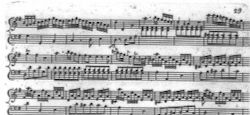This essay is the first of a series devoted to changing-note schemata, a type of dichotomous schema with a treble and/or a bass whose melodic shape look like a gruppetto or a musical turn (~). In this essay, I will discuss the schema that Robert O. Gjerdingen has labelled the Meyer, after Leonard B. Meyer (1918–2007), one of Gjerdingen’s professors who was the first to point at this (type of) schema.
A Meyer is a dichotomous schema that features a ➊–➐…➍–➌ treble line. As for the counterpoint in the bass, there are several possibilities. The counterpoints on which Gjerdingen focusses are the following two: ①–②…⑦–① and ①–②…⑤–①.
To facilitate the reading of this essay, I use Robert Gjerdingen’s black-circled figures to indicate scale steps in an upper part (e.g. ➍–➌) and white-circled figures to indicate scale steps in the bass (e.g. ⑦–①). And I add an accidental to a figure when the specific designation of a diatonic or a chromatically altered scale step is required, although this symbolized notation can differ from the actual one. The list below should suffice to make the system of indications clear. Regardless of the mode,
♭③ always refers to the scale step a minor third above ①
③ always refers to the scale step a major third above ①
♭⑥ always refers to the scale step a minor second above ⑤
⑥ always refers to the scale step a major second above ⑤
♭⑦ always refers to the scale step a major second below ①
⑦ always refers to the scale step a minor second below ①
Note further that ‘bar 1a’ refers to the first half of bar 1, ‘bar 1b’ to its second half.
Term and Interpretation
The term and interpretation of the Meyer come from Robert O. Gjerdingen. He defines a Meyer as a proposta schema that comprises two dyads, as do the Fonte and Monte. Contrary to both dyads of the Fonte and Monte, however, those of the Meyer clearly and stably belong to only one key. The Meyer being characterized by its upper part, the schema’s first dyad has a ➊–➐ snippet, the second a ➍–➌ snippet.
The ➊–➐…➍–➌ treble line of the Meyer can have several counterpoints.
The Meyer with a ①–②…⑦–① Bass Line
A first possible counterpoint to the ➊–➐…➍–➌ treble line of the Meyer is the ①–②…⑦–① bass line, making the second dyad into a clausula cantizans. Mozart begins the first movement of his Keyboard Sonata in G major KV 283 with this type of Meyer:

The second and fourth structural notes of the treble line of this type of Meyer —or of any type of Meyer, as a matter of fact— can be delayed by means of a suspension. Mozart does this at the beginning of the third movement of his Keyboard Sonata in C minor KV 457. (I have indicated the suspensions with a blue arrow.)

Note
- how each dyad also begins with a syncopation in the right hand, the second of which is a suspension
- the ♭➏–➎–➍–♭➌ descent in the treble line during the second dyad (bars 2b–4), a typical melodic gesture of any clausula cantizans
- how the anticipated ♭➏ on beat 3 of bar 2 creates a 6♮/5♭/3 instead of a 6♮/3 or 6♮/4/3 sonority.
Gjerdingen further points out that the treble of the second dyad doesn’t necessarily have to be a fourth higher but can also occur a fifth lower. He gives the following example by Haydn to illustrate this:

Note that in this case only stage 2 is embellished with a suspension (indicated by the blue arrow).
This is also the case in the following example, an excerpt in A minor from a minuet in A major by Domenico Cimarosa. Note again the ♭➏–➎–➍–♭➌ descent in the treble line during the second dyad (bars 20–21).

The Metrically Shifted Meyer with a ①–②…⑦–① Bass Line
In the examples we saw until now, both dyads of the Meyer have the same metrical organization. However, stage 2 can be doubled in length so that stage 3, also an unstable chord, starts on a similarly weak beat as does stage 2 and that stage 4, set with a triad, starts on a similarly strong beat as does stage 1, also set with a triad. Such a metrically shifted Meyer occurs at the very start of Haydn’s oratorio Il ritorno di Tobia:

Note
- that stage 2 is not set with a 6♮/4/3 but with a 6♮/5♭/3 chord
- the ♭➏–➎–➍–♭➌ descent in the treble line during the second dyad (bars 2b–3a)
- that the treble line doesn’t include suspensions
- the 9–8 suspension in the second violin during stage 4 (bar 3a)
The Meyer with a ①–②…⑤–① Bass Line
The third structural note of the bass line could also be ⑤ instead of ⑦, resulting in a somewhat stronger cadential closure of the Meyer (clausula basizans). Carl Friedrich Abel (1723–1783), a German gambist and composer, included such a Meyer in the first movement of his fifth keyboard concerto in D major op. 11:

Haydn uses the same type of Meyer to begin the finale of his Keyboard Sonata in D major Hob. XVI: 37, yet writes the second dyad in the left hand an octave higher:

The Meyer with a ①–⑤…⑤–① Bass Line
The treble line of a Meyer can also be accompanied with a ①–⑤…⑤–① bass line. An example of this type of Meyer can be seen and heard at the beginning of the minuet from the first Keyboard Sonata from Sonate per Gravicembalo by the Venetian composer Giovanni Battista Pescetti (1704–1766):

Note the (suggestion of a) triad on ④ between stages 1 and 2 (beat 3 of bar 1).
Also in this variant, suspensions can occur at the beginning of stages 2 and 4. The opening movement —an Adagio— of the same keyboard sonata by Pescetti opens with a Meyer in which stages 2 and 4 are set with a 4–3 suspension. (I have indicated the suspensions with a blue arrow.)

Carl Philipp Emanuel Bach chooses to begin the opening movement of his Keyboard Sonata in G major Wq. 65/22 with a Meyer in which stages 2 and 4 include not one but two suspensions, the first one creating a cadential 6/4 chord, the second a 9/4 suspension. (I have indicated the suspensions with a blue arrow.)

In the sublime terzetto Soave sia il vento from the first act of Così can tutte, Mozart goes even a step further and embellishes the double suspensions:
- those at the beginning of stage 2 with escape notes
- those at the beginning of stage 4, resulting in what seems to be a triad of the downbeat of bar 6:

Although stages 2 and 4 are usually treated in the same way with regard to the number of suspensions, you may encounter some examples of Meyers where that isn’t the case. (We already saw some such examples.) Consider the beginning of the third movement of Haydn Keyboard Sonata in F major Hob. XVI: 23:

In this case, stage 2 is embellished with a double suspension (in the form of a cadential 6/4 chord, indicated by two blue arrows), stage 4 only with a 4–3 suspension (indicated by the one blue arrow).
Note further
- the triad on ④ between stages 1 and 2 (beat 2 of bar 1) (contrary to bar 1 of Pescetti’s minuet in E major, ④ cannot be interpreted here as a passing note due to the presence of the third)
- the High ➋ Drop in bar 3b–4a.
The Meyer with a ①–⑤…⑦–① Bass Line
The treble line of a Meyer can also be accompanied with a ①–⑤…⑦–① bass line. Haydn writes such a Meyer to open the Adagio (in F major) of his Keyboard Sonata in C major Hob. XVI: 35:

Note that this Meyer doesn’t include any suspensions in the upper part during the second and fourth structural notes. However, an Inventio in C major by Johann Philipp Kirnberger (1721–1783) that begins with the same type of Meyer does include suspensions:

The Meyer with a ①–②…⑤–⑥ Bass Line
While in all the Meyers we saw above both the opening and closing bass notes are ①, a composer may decide to replace the closing bass note with ⑥, creating a ⑤–⑥ cadence. Mozart uses this variant as opening gesture of the first movement of his Gran Partita:

For more repertory examples of the Meyer check out the following videos by John Rice:
Further Reading (Selection)
Gjerdingen, Robert O. Music in the Galant Style (New York: Oxford University Press, 2007).
Gjerdingen, Robert O. Child Composers in the Old Conservatories — How Orphans Became Elite Musicians (New York: Oxford University Press, 2020).
IJzerman, Job. Harmony, Counterpoint, Partimento: A New Method Inspired by Old Masters (New York: Oxford University Press, 2018).
